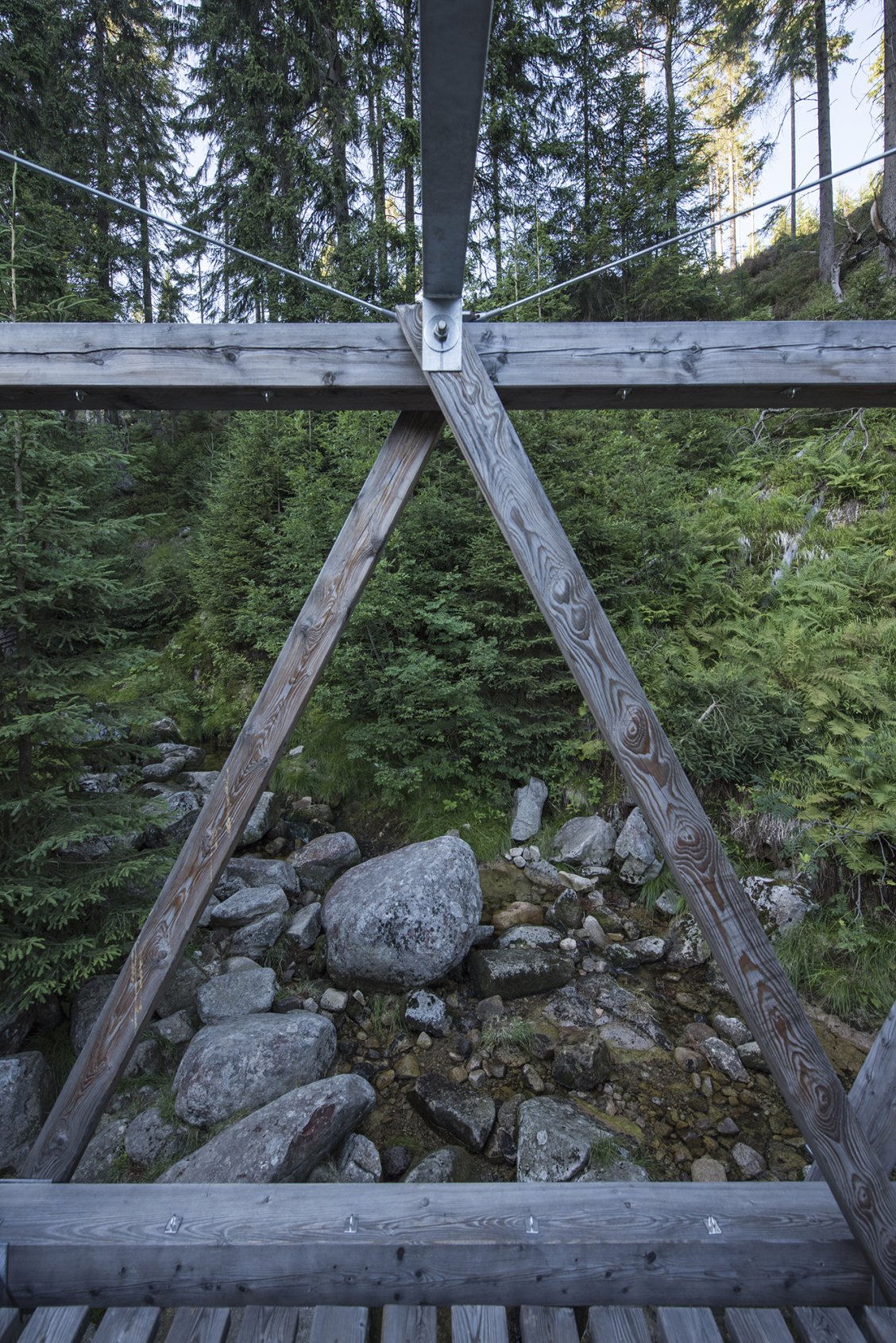People can already walk over our footbridges in Krkonoše mountains
9/12/2019

A total of 30 students from 5 studios of the Department of Design Studio II of the CTU in Prague participated in the project. “After success in the international Solar Decathlon competition, the footbridges for KRNAP were the first major design-build project of our department. We wanted to offer students an alternative to the prevailing traditional teaching so that they could draw paper designs into real construction, ” recalls the beginning of the project in 2017 Dalibor Hlaváček, head of the department. The result is a total of five footbridges - two with benches on Klínová cesta, construction in the form of a truss girder across the Medvědí potok, a triangular footbridge at the Hrnčířských bud and a footbridge for pedestrians and cars in Eliščino údolí.
Working on the territory of the Krkonoše National Park posed many challenges for students. They had to devise footbridges in a such way that they could be dismantled and elements could be easily handled without heavy equipment. Some of the footbridges are located in avalanche areas where their shape and construction resist the impact of large amounts of snow.
Extreme climatic conditions were a key aspect of material selection. Therefore, the authors of the footbridge over the Hluboká strouha chose the weather-resistant Corten steel and underwent a welding course in order to produce walkable grids themselves. The other option was they designed more complicated parts of steel when due to the tradition and character of the place, they did not want to lose aspect of the wood that belongs to the mountains.
Students started to work on the designs in October 2018, then the construction was carried out with the assistance of professionals, engineers and craftsmen, in January 2018 in front of the Faculty of Architecture of the Czech Technical University. “The subtlety of the footbridge construction at Hrnčířské bud was born thanks to the inspiring cooperation with the engineer of the Troja Bridge, ing. Vladimír Janata,” says Hana Seho, head of one of the studios and project coordinator.
In July 2019, KRNAP workers installed footbridges to the final locations in the mountains. Before installation, they had to remove the original bridges and modify the terrain. The most difficult preparation was at Rennerův potok in Eliščino údol, where it was necessary to repair pillars from the local stone into which the footbridge is anchored. On the other hand, it was possible to bring the footbridge here and mount it with a crane. The other footbridges in more distant locations were transported to the sites manually, yet their installation did not take more than 14 days.
According to Radek Drahny, a spokesman for KRNAP Administration, a cooperation with students of architecture is mutually beneficial: “Young people are open to non-traditional solutions and come up with suggestions that may be of interest to ordinary mountain visitors. At the same time, they can participate in the creation of something real and useful.”
The footbridge Medvědí boudy, 50.7641311N, 15.5906222E
Pedagogical leadership: Petr Kordovský, Ladislav Vrbata, Studio Kordovský
Team of students: Ondřej Novák, Jakub Bilan, Tereza Kosíková, Adéla Šeflová, Nina Třísková, Irena Zmeškalová
The footbridge on the Medvědí potok is located on a hiking, cycling and cross-country trail directly connecting the east with the west of the Krkonoše. A simple but distinctive wooden lattice structure spans the valley of the Medvědí důl at a height of 1,020 meters above sea level.


The footbridge over Hluboká strouha, Klínová cesta, 50.7171494N, 15.6340978E
Pedagogical leadership: Dalibor Hlaváček, Martin Čeněk, Studio Hlaváček – Čeněk
Team of students: Tomáš Minarovič, Michal Bílek, Jan Binter, Tereza Chvojková, Ondřej Králík, Matěj Kulhavý, Petra Lálová, Eliška Müllerová, Pavel Struhař
The minimum number of resting places and unique views of the valley are behind the concept of the footbridge over the Hluboká strouha. The footbridge is located on the hillside of Stoh, at a place where the deep tourist ditch is overcomed by a blue hiking trail leading from Špindlerův Mlýn to Klínové Boudy. Its shape is based on the terrain configuration of the trough and the movement of visitors. Part of the footbridge is a bench that turns towards the valley.


The footbridge over Černá strouha, Klínová cesta, 50.7163308N, 15.6238436E
Pedagogical leadership: Josef Mádr, Šárka Malošíková, Studio Mádr
Team of students: Tereza Červená, Daniel Homola, Lucie Kolenová, Jakub Svitek, Adam Škarka
The footbridge in the avalanche area follows the terrain and naturally turns in the direction of the trail. The two main beams overcome a 7 meter span and naturally link two different height levels. There is a bench along the upper line of the external beam, overlooking the valley. Cedar wood, from which the footbridge is made almost two years after completion, still smells exotic.


The footbridge at Hrnčířské budy, Idina cesta, 50.6703531N, 15.7133542E
Pedagogical leadership: Hana Seho, Jan Světlík, Studio Seho
Team of students: Anna Bredová, Monika Jůzová, Vojtěch Sigl, Matouš Štrba, Štěpán Tylš
The footbridge over Čistá near Hrnčířské budy is located in a narrow ravine and in a sharp turn. Its spatially distinctive form consists of seven wooden isosceles triangles that are connected by steel elements and float due to steel rods. In this basic design box is inserted the “tread” of the footbridge made of planks. Anyone who walks through the footbridge can explore every detail and touch the elements.


The footbridge over Rennerův potok, Eliščino údolí, 50.7265942N, 15.8108042E
Pedagogical leadership: Zdeněk Zavřel, Robert Jelínek, ateliér Zavřel
Team of students: Adam Bujok, Michaela Černá, Anton Lukáč, Vojtěch Palm, Filip Zdvořák
The footbridge in Eliščino údolí near Rennerových bud is designed to be driven over by car. In principle, robust and heavy construction elements were avoided by students in a way that they assemled the load-bearing structure from multiple shorter timber beams that could be handled better. The proposal also limits large areas where water could adhere. Authors chose traditional local wood material, fasteners are made of steel due to their durability.


